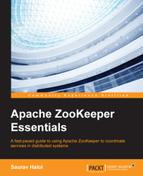ZooKeeper's data model provides a mechanism to control the access to znodes using ACL. While creating a znode, the ACLs determine the permissions with respect to the various operations that you can perform on the znodes. The ZooKeeper ACL model is similar to the Unix/Linux file permissions in terms of permitting or preventing operations being done on a znode by setting/unsetting permission bits. However, the ZooKeeper node doesn't have the concept of ownership, which is present in the Unix/Linux filesystem. ACLs are determined on the basis of the authentication mechanism of the client and the ZooKeeper service.
ZooKeeper provides the following built-in authentication mechanisms based on ACLs:
In addition to the authentication schemes mentioned in the preceding list, ZooKeeper also supports a pluggable authentication mechanism, which makes it possible to integrate third-party authentication schemes if needed. Any authentication schemes in ZooKeeper consist of the following two main authentication operations:
- Firstly, the authentication framework in ZooKeeper authenticates the client. The client authentication occurs when the client connects to the ZooKeeper service by validating client information.
- Secondly, the authentication framework finds the entries in the ACL, which correspond to the client. ACL entries are pairs that consist of <IDs, Permissions> pairs, where IDs are some strings that identify the client.
An important point about znode ACLs is that the ACL associated with a particular znode doesn't propagate to its children. A client's authentication with ZooKeeper is optional; if the ACLs associated with a znode require a client to authenticate, then it must authenticate using any of the previously mentioned authentication mechanisms. An ACL is the combination of an authentication mechanism, an identity for that mechanism, and a set of permissions.
ZooKeeper's ACLs support the following permissions:
|
Operation |
ACL Permission |
|---|---|
|
|
Creates a child znode |
|
|
Gets a list of child znodes and the data associated with a znode |
|
|
Sets (writes) data to a znode |
|
|
Deletes a child znode |
|
|
Sets ACLs (permissions) |
Any client that is connecting to a ZooKeeper service has the permission to check the existence of a znode. This exist operation is permission-free, which allows to retrieve the stat structure of a znode. We will read about the stat structure of ZooKeeper in the next section.
There are a number of predefined ACLs in ZooKeeper. These IDs, as defined by ZooKeeper ACLs, are shown in the following table:
